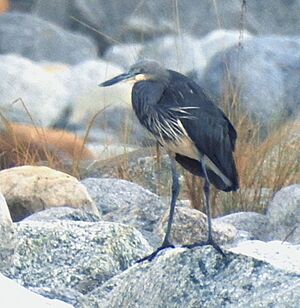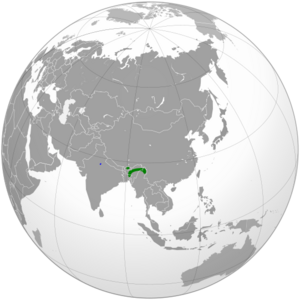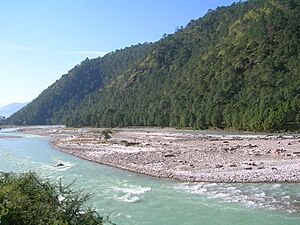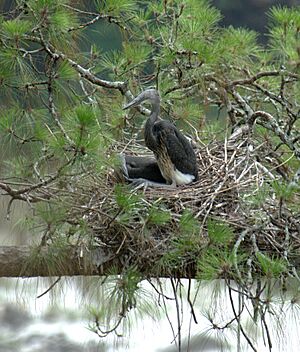White-bellied heron facts for kids
Quick facts for kids White-bellied heron |
|
|---|---|
 |
|
| At Namdapha National Park | |
| Conservation status | |
| Scientific classification | |
| Genus: |
Ardea
|
| Species: |
insignis
|
 |
|
| Synonyms | |
|
|
The white-bellied heron (Ardea insignis) is a very large and rare bird. It is also known as the imperial heron or great white-bellied heron. This heron lives in the mountains of the eastern Himalayas, in places like northeast India, Bhutan, and northern Myanmar. It likes to live near quiet rivers and wetlands. This amazing bird is in big trouble. Since 2007, it has been listed as Critically Endangered on the IUCN Red List. This means there are very few left, maybe fewer than 300 adult birds in the whole world. Their homes are disappearing, and people disturb them too much. The white-bellied heron is mostly dark grey. It has a white throat and a white belly.
Contents
The White-Bellied Heron: A Rare Giant Bird
The scientific name for this heron is Ardea insignis. This name was first suggested by Brian Houghton Hodgson in 1844. Later, in 1878, Allan Octavian Hume officially described the bird using this name. For a while, some people called it Ardea imperialis. But now, Ardea insignis is the correct and accepted scientific name for this special heron.
What Does This Heron Look Like?
The white-bellied heron has feathers that are mostly dark grey. Its belly is whitish. It also has long, shiny plumes (special feathers) on the back of its head and on its neck. When it's time to breed, it gets even more special feathers. These include a greyish-white plume on its neck and long grey feathers on its chest with white centers.
Its face is a greenish-grey color. The bill (beak) is black and about 15 to 18 centimeters long. But near the base and tip, the bill can look a bit greenish. Its eyes are yellow, and its legs and feet are a dull grey. Young herons are a bit browner on top. Their bills and legs are also lighter in color. When this heron flies, its upper wings look dark grey. The feathers under its wings are white, which stands out against the dark grey flight feathers.
This heron is very tall, standing about 127 centimeters (about 4 feet 2 inches) high. This makes it the second largest heron in the world! Some measurements from a heron in 1903 showed its wing bones were about 61 centimeters long. Its wings could spread out to about 102 centimeters. The total wingspan was around 213 centimeters (about 7 feet). These herons usually weigh between 3.2 and 3.4 kilograms.
Where Does the White-Bellied Heron Live?
The white-bellied heron lives in the wet areas of tropical and subtropical forests. These forests are found in the foothills of the eastern Himalayas. You can find them in northeast India and Myanmar. They also live in Bhutan, especially near rivers at lower elevations, below 1,700 meters.
In Bhutan, they like the area around the Sankosh River and its smaller rivers. They have been seen nesting there, building their homes in tall trees like chir pine, champak, and bayur. These nests are found at heights from 400 to 1,430 meters.
In India, they have been seen in places like Kaziranga National Park and Pobitora Wildlife Sanctuary in Assam. In Arunachal Pradesh, repeated sightings along the Namdapha and Noa Dihing Rivers show that Namdapha National Park is a very important safe place for them to live and raise their young. In northern Myanmar, they have been seen along streams in the Hkakabo Razi area.
How Does This Heron Behave?
When a white-bellied heron feels bothered or scared, it makes a deep, croaking sound. It sounds like “ock ock ock ock urrrrrr”. During the time they breed, these herons call out a lot in the early morning. They call most often just before the sun comes up. They also call frequently late at night, but rarely during the day.
During the day, these herons often rest for a long time, sometimes up to six hours. They like to rest on bare sandy spots, big rocks, logs, or in trees. Sometimes, they even lie down on their chests. At night, they sleep with their head tucked into their chest. They hold onto their perch with one leg, while the other leg is pulled up into their belly feathers. Adult herons usually rest alone, but young herons often rest in pairs.
What Does It Eat?
The white-bellied heron prefers to find food in shallow parts of rivers. They like areas with many channels, about 200 meters wide. They also look for food in shallow ponds and pools found on river islands. They mostly eat a type of fish called Schizothorax carps all year round. In the spring, they might also eat brown trout. During the summer, they eat Garra fish species. When they are looking for food, they can spend anywhere from 5 to 58 minutes at a time.
Why Is This Heron in Danger?
The white-bellied heron is in danger because its home is being lost. People are disturbing them more and more. Their wet habitats are being changed for farming or new towns. Resources from wetlands are being taken, and sometimes, people illegally hunt them. This heron has already disappeared from Nepal and possibly from Bangladesh.
In Bhutan, there are four big hydropower projects. These projects are in places where the white-bellied heron lives. Rivers are also being used for digging up gravel and sand. Forest fires have also harmed the places where these birds nest.
Protecting the White-Bellied Heron
In India, the white-bellied heron is very protected under a law called the Wild Life (Protection) Act, 1972. In Myanmar, it has had the highest level of legal protection since 1994. Since 2007, it has been listed as Critically Endangered on the IUCN Red List. This means experts believe there are fewer than 250 adult birds left, and their numbers are going down quickly.
There is hope for these birds. In May 2011, a white-bellied heron chick was hatched in captivity for the very first time. This young bird was then released into the wild in September 2011 in Bhutan's Punakha District. This shows that people are working hard to save this rare and beautiful bird.





